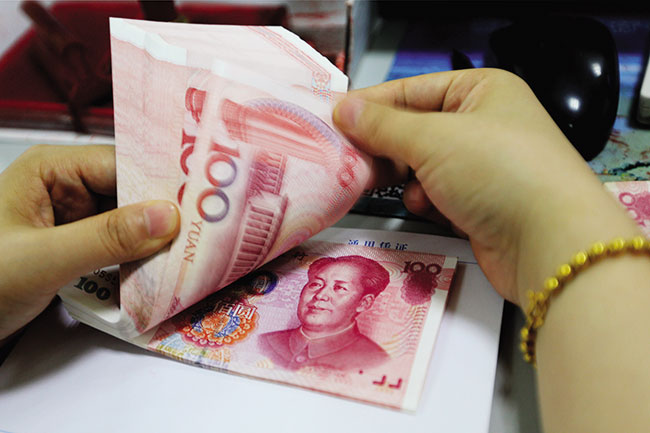China eyes global reserve currency status for yuan

The CNY still needs to clear a few hurdles to become the first international currency from a developing country
By Nguyen Thi Thuy Linh - Research Department VPBank Securities
Meanwhile, the International Monetary Fund (IMF) decided to add the CNY to its Special Drawing Rights currency basket, which will take effect in October this year, beside other currencies such as the USD, EUR, JPY, and GBP.
The question is: should Vietnam increase CNY holdings in its foreign currency reserves?
An international currency should possess three important cross-border functions: storing of value, medium of exchange, and unit of account. According to the Asian Development Bank, there are three sets of factors that are critical to producing an international currency: economic weights, openness and depth of financial markets, and credibility of economic and legal systems.
Comparing China’s situation using these criteria may suggest that while the CNY’s international role is likely to rise in the coming years, it would be difficult for it to become a global reserve currency anytime soon.
The first factor should create more chances to use a country’s own currency in international transactions. It is useful to note, however, that while economic weights are important, they are perhaps not the most fundamental factors. Nonetheless, China’s rising importance in global GDP and trade has already generated some demand for the CNY as a settlement currency. It is not too difficult to imagine such demand rise rapidly as China becomes the largest economy in the world over the coming decade.
The second factor determines how easily non-residents can access the currency, make an investment, liquidate it, and hedge the risk. With capital account controls and primitive financial markets, China lags significantly in this area, which needs to be improved before the CNY can truly become an international currency.
The third factor underscores investor confidence in the currency by supporting currency, financial, economic, and even political stability. It is perhaps no coincidence that all existing global reserve currencies are from developed economies. This is probably the most difficult area for China to catch up. The gaps between China and those existing international currency countries in economic freedom are very wide, especially in the legal system and property rights, sound money, and regulation.
China has adopted a two-track approach in internationalising the CNY: one is to promote the international use of the CNY and the other is to liberalise the capital account. Most of the authorities’ recent policy actions are related to the first track. These include use of the CNY in trade and investment settlement, setting up of offshore markets, issuance of CNY-denominated securities products overseas, holding of CNY as part of foreign central banks’ currency reserves, and adding CNY to the IMF’s SDR basket, among others. Still, these measures are insufficient to improve the currency’s credibility.
An international currency is one that non-residents would use not only in normal times but also depend on in times of crisis. Therefore, having a strong economy and an open market is not sufficient. The US dollar served as a global currency during much of the 20th century because of the well-established legal system in the US and the Federal Reserve System, as well as its efficient market and strong economy. This is perhaps the highest hurdle that China will need to overcome in order to make the CNY an international currency. If China succeeds, it would be historic because it would be the first time in centuries that a developing country’s currency becomes a global currency—and developing economies by definition are unstable, volatile (although often with stronger growth), and vulnerable in the face of shocks.
China’s economy is facing various structural issues and may soon encounter a period of slowdown. Consequently, there is a strong likelihood that the CNY will depreciate significantly in the years to come. Vietnam, therefore, should not increase its reserve in CNY-denominated assets just yet.
What the stars mean:
★ Poor ★ ★ Promising ★★★ Good ★★★★ Very good ★★★★★ Exceptional
Latest News
More News
- Standard Chartered flags global infrastructure financing gap (November 28, 2025 | 18:00)
- Ho Chi Minh City taps Ant International to strengthen fintech and IFC ambitions (November 27, 2025 | 10:00)
- Nam A Bank and GCPF partner on climate adaptation finance (November 24, 2025 | 19:00)
- Thailand’s Café Amazon exits Vietnam after five years (November 22, 2025 | 12:56)
- PVT Logistics debuts on HSX (November 21, 2025 | 14:01)
- JBIC and BIDV join forces to back Vietnam’s green transition (November 19, 2025 | 15:50)
- Vietnam’s financial sector drives $1 billion IPO surge (November 19, 2025 | 15:44)
- Bank stocks gain appeal on strong credit growth and expanding ecosystems (November 18, 2025 | 15:22)
- Banks raise deposit rates as year-end lending heats up (November 17, 2025 | 07:35)
- VNU-UEB conference highlights risk management and fintech strategies (November 16, 2025 | 16:00)

















 Mobile Version
Mobile Version